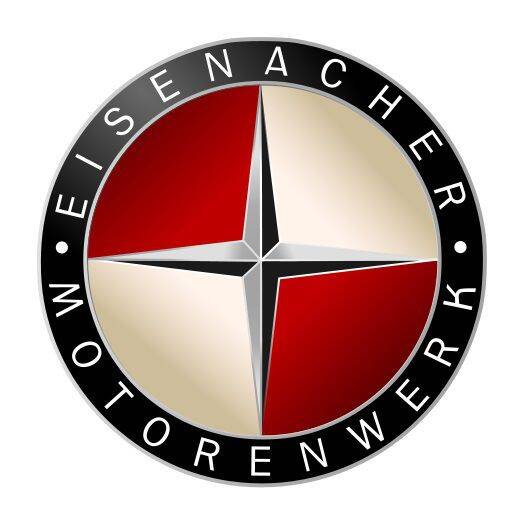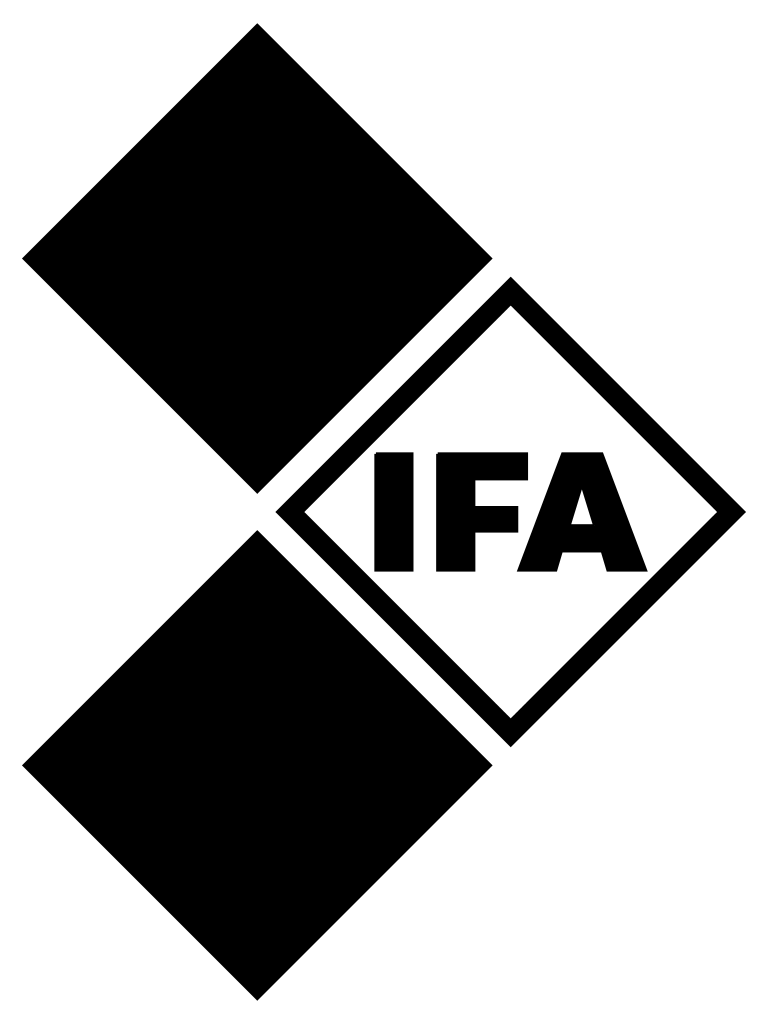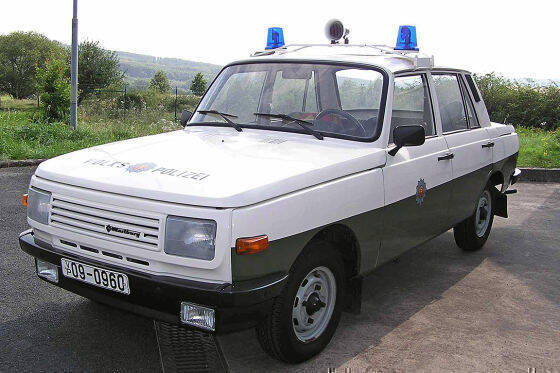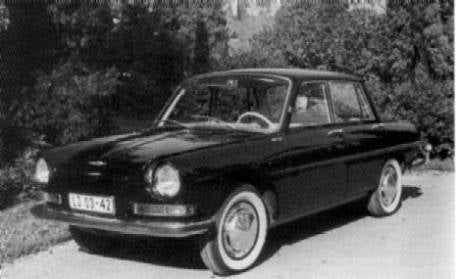







The Wartburg was a car marque known for its East German manufactured models, but has its origins dating to 1898. The name derives from Wartburg Castle on one of the hills overlooking the town of Eisenach where the cars were made. Heinrich Ehrhardt founded the Fahrzeugfabrik Eisenach (FFE) in Eisenach on 3 December 1896 as a stock company. Initially he produced bicycles and guns, but after two years he started to produce a motor car which he called the Wartburg, a licensed model of the French Decauville. The company was the third to manufacture cars in Germany, the first being Benz & Cie and the second being Daimler Motoren Gesellschaft. His son Gustav subsequently took over the factory, which at the end of the 19th century employed 1,300 workers and was one of the largest in Thuringia.

1898 Wartburg Motorwagen - MKModelle - 1/24
In 1903, the Ehrhardt family withdrew from management due to financial losses and also because the license to build Decauvilles was revoked. The factory began building under the new name, Dixi, in 1904 with Willi Seck as chief engineer. The top model, the type U35, was introduced in 1907 and was soon recognized for its reliability and performance with 65 hp and a top speed of 85 km/h.
During World War I the company produced trucks and guns. Afterwards the factory suffered from reparations with removal of equipment. In 1919, car production resumed with the company renamed as Dixi-Werke AG in 1920; but soon economic hardship forced a merger with Gothaer Waggonfabrik AG. Another result of the economic downturn was a change in output, focusing on small cars. In 1927 Dixi produced the DA-1 3/15, a version of the British Austin 7 built under licence.

In November 1928 BMW acquired the Fahrzeugfabrik Eisenach A.G. (Marke "Dixi") from the Gothaer Waggonfabrik bringing the independent existence of Dixi to an end and the Eisenach factory became the birthplace of car manufacturing by BMW. The Dixi continued briefly as the BMW Dixi but the renamed BMW-Factory Eisenach soon started making an updated version of the car called the BMW 3/15PS dropping the Dixi name. By 1931, 25000 cars had been produced in a series going from DA 1 to DA 4. The DA-3, a sporting version, saw a re-appearance of the Wartburg name. In 1932 a new small car, the 3/20 AM-1, was announced with independent suspension all round and an enlarged 788cc (48ci) engine.
In 1933 BMW started to develop bigger cars with 6-cylinder engines. The first car of which was the BMW 303. Later successors were the BMW 315, BMW 319, BMW 327 and the elegant sports coupe BMW 328.
In 1942 BMW moved its motorcycle production to Eisenach, freeing up space in Munich for air craft engines. The main product was the highly successful R75 .In 1942 regular automobile production was stopped because of World War II and started to manufacture aircraft engines for the Luftwaffe. By the end of the war about 60% of the factory had been destroyed.

1930 BMW 3/15 PS DA3 Wartburg Spezial Roadster
From 1930, BMW offered enthusiastic drivers a special treat in the form of the tiny type 3/15 PS DA 3 Wartburg Sport, based on the English Austin 7 "Ulster". For the first time since 1903, a car again bore the name of the Wartburg, the castle that is a landmark above the town of Eisenach. The small roadster, with what was then regarded as a very smart boat-type tail, had a 750-cc, four-cylinder engine which had been tuned from 15 to 18 horsepower by increasing the compression and using a copper induction manifold and a twin exhaust system. The sports car, weighing only 400 kilograms, had a top speed of over 90 km/h and developed into a popular and successful competition car. Only 150 of these thoroughly charming roadsters, the founders of BMW's automobile sport history, were sold up to 1931.
After the war, Thuringia was part of the Soviet sector, and the factory became a Soviet Stock company named Sowjetische AG Maschinenbau Awtowelo, Werk BMW Eisenach (Soviet Awtowelo Co., Eisenach BMW Works). Production restarted with the BMW 321, of which almost 4,000 were made between late 1945 and 1950. A handful of BMW 326s were made in 1946-7 and 161 EMW 325/3s (bucket car) were made in 1952. In 1949 the Eisenach works launched the BMW 340 (a development of the BMW 326 with modified front and rear bodywork) and the BMW 327.
As long as the Soviets owned the company, BMW in Munich could not bring legal proceedings to protect its tradename. As the Munich factory was not producing cars yet, all "BMWs" made from 1945 to 1951 are Eisenach products.
In 1952 the works were transferred to ownership by the East German government and renamed EMW or Eisenacher Motorenwerk (see below). It continued type 327 production and further developed the type 340 as the EMW 340-2. Production of both models ceased in 1955, by which time Eisenach had produced a total of over 21,200 BMW/EMW 340s and 400 BMW/EMW 327s. Total production of four-stroke automobiles between 1945 and 1955 was just over 30,800.

In 1952, the Soviet owners handed the company over to the German Democratic Republic, and it became a state-owned company. By that time BMW from Munich was able to secure its tradename, logo, and typical double-nostril grille appearance, and started to produce cars again. The Eisenach company was renamed Eisenacher Motorenwerk (EMW), its logo being a variation of the BMW logo, the blue quadrants replaced by red ones. EMW participated in the 1953 German Grand Prix. One year later it received its final name VEB Automobilwerk Eisenach (AWE).

After the war, Eisenach fell within Communist ruled East Germany. The car and motorcycle factories in Eisenach were incorporated into Industrieverband Fahrzeugbau, or IFA. The group incorporated all the major vehicle manufacturers in East Germany. Production of cars and motorcycles restarted in the Eisenach factories with modified versions of pre-war BMW cars and motorcycles. Initially these were sold under the BMW badge but this was quickly changed to avoid problems with BMW in West Germany. Cars were subsequently badged as Autowelo and later as EMW (Eisenach Motoren Werke) as they were further developed while motorcycle production faded away.
There was a great need in the Eastern Bloc countries for cars that were simple to build, maintain, and own. There was also a need to export cars and earn vital foreign currency. As a first step to achieving this, production of the IFA F9 car was moved to Eisenach. The East German version, the IFA F9, was initially produced in Zwickau by the Sachsenring factory which was later to go on to produce the Trabant.
f9
The name Wartburg was revived in 1956 by VEB Automobilwerk Eisenach and given to an updated version of their IFA F9 car which had been in production since 1950. The new car had a more powerful version of the three-cylinder two-stroke engine driving the front wheels and a completely new body. By this time, Germany had been divided into two countries (the West and the East) and the Wartburg factory was in the communist East (GDR).

1950-1956
The IFA F9, subsequently rebadged as the EMW 309, was a compact saloon manufactured under the auspices of the Russian and East German states between 1949 or 1950 and 1956. It was initially built at Zwickau at the plant previously owned by Auto Union. In 1953 production was transferred to the EMW, former BMW manufacturing plant at Eisenach under the name EMW 309 until 1956 where its underpinnings subsequently found their way into the Wartburg 311.
The F9 featured a three-cylinder two-stroke water-cooled engine of 910 cc with a claimed output, at launch, of 28 bhp. The engine was water-cooled, the radiator being located behind the engine, an unusual configuration but one also found on the DKW F91. The front wheels were driven via a four-speed manual gear box with a free wheel.
311

1956-1965 sedan

coupé

kombi

camping
The Wartburg 311 was a car produced by East German car manufacturer VEB Automobilwerk Eisenach from 1956 to 1965. The 311 model was manufactured in a number of variations, including pickup, sedan, limousine, coupé, and as a two-seat roadster. The two-stroke engine was enlarged to 992 cc in 1962. An interim model, called the Wartburg 312 and featuring the chassis developed for the succeeding 353, was built from 1965 until 1967. Production of the Wartburg 311 was already underway at Eisenach by the end of 1955. The car was a development of the existing EMW 309. This was the car previously identified as the IFA F9, which, in turn, had been based on the 1940 DKW F9 scheduled for launch in 1940 until the Second World War intervened. The "311" designation followed the tradition of the plant's previous owner, BMW, whose Eisenach-produced passenger cars had all been identified by a three-digit number starting with a "3".
In Argentina a small two-door sedan with small, two-stroke two- and four-cylinder engines had been built by IAME in Córdoba between 1952 and 1955 as the Justicialista. After the 1955 coup d'état, IAME was renamed DINFIA. From 1956 it was equipped with the 901 cc engine from the Wartburg 311, it looked mostly the same, but its name was changed to Graciela. It was built in 2280 examples until 1961. Pickup and van versions were also available. From 1962 the local bodywork was replaced with that of the four-door Wartburg 311; this was sold as the Graciela W. It retained the same engine, and 646 were built until 1964.
Wartburg 311
- 311/0 Standard Limousine (four-door sedan)
- 311/1 Luxus-Limousine (four-door luxury sedan)
- 311/2 Cabriolet two-door (since March 1956)
- 311/3 Coupé 2-door
- 311/4 Kübelwagen (Police off-road), only 891 were produced (1959 - 1964)
- 311/5 Camping-Limousine (five-door station wagon)
- 311/6 Limousine (RHD four-door sedan)
- 311/7 pickup two-door (since March 1956)
- 311/8 Schiebedach-Limousine (four-door sedan, with sunroof)
- 311/108 Luxus-Limousine (four-door luxury sedan with sliding sunroof)
- 311/9 Kombi (station wagon) 3-door (since March 1956)
- 311-300 Hardtop Coupé (HT) 2-door
- 313/1 Sportwagen (two-door roadster / since the spring of 1957, with 50 hp)
Wartburg 312
- 312/0 Standard Limousine (4-door sedan)
- 312/1 Luxus-Limousine (4-door sedan)
- 312/5 Camping-Limousine (5-door station wagon)
- 312-300 Hardtop-Coupé (HT) 2-door
- 312 Pick-up truck. It is unknown whether they were made by the factory, or were later conversions. However, the later 353 was available as pickup truck.

Industrias Aeronáuticas y Mecánicas del Estado (Spanish for State Aeronautical and Mechanical Industries, abbreviated IAME) was a State-owned entity and autarchic conglomerate of factories of Argentina created in 1951 to promote the manufacture of aircraft and automobiles.
The company was established to manufacture automobiles in the country, taking advantage of the advances of Aerotechnical Institute of Córdoba Province.[2] At its peak, IAME manufactured (apart from automobiles) airplanes, tractors, motorcycles, motorboats, and weapons. In 1956 it was renamed "Dirección Nacional de Fabricación e Investigación Aeronáutica" (Spanish for National Directorate of Aeronautical Manufacturing and Research, abbreviated "DINFIA").
In 1967, it was established that DINFIA focused on aeronautics and aerospace, while the automotive division would be taken over by another company created with that purpose, "Industrias Mecánicas del Estado" (IME).
The first car manufactured by IAME was the Justicialista model in 1952. This car had a body designed in Argentina but inspired on the Chevrolet models of those times. They were powered with Wartburg engines imported from Germany. The first prototype was developed and built in only 90 days, using national materials for manufacturing it. The Justicialista line included a sedan, the chatita (small pickup), van, and a sport coupe. They were sold at low prices, with a total of 3,730 units produced.

i.a.m.e.

Comienzo Fabricación: 1956
Término de Fabricación: 1961
Origen: Argentina
Denominación Original: sedán Justicialista
Carrocería: Sedán Sobre Bastidor
Puertas: 2
Motor: Wartburg 3 en línea

Comienzo Fabricación: 1962
Término de Fabricación: 1964
Origen: Alemania Oriental
Denominación Original: Wartburg 311 (1956)
Carrocería: Sedán Sobre Bastidor
Puertas: 4
Motor: Wartburg 3 en línea

Comienzo Fabricación: 1952 (1953 Furgón)
Término de Fabricación: 1957 (1956 Furgón)
Origen: Argentina
Denominación Original: Pick-Up Justicialista
Carrocería: Pick-up Sobre Bastidor

Comienzo Fabricación: 1952 (1953 Furgón)
Término de Fabricación: 1957 (1956 Furgón)
Origen: Argentina
Denominación Original: Pick-Up Justicialista
Carrocería: Pick-up Sobre Bastidor

353

1966-1988



The Wartburg 353, known in some export markets as the Wartburg Knight, is a medium-sized family car, produced by the East German car manufacturer AWE for their Wartburg brand. It was the successor of the Wartburg 311, and was itself succeeded by the Wartburg 1.3.
The Wartburg 353 was produced from 1966 to 1988, becoming the Wartburg with the longest production run. During its lifetime it saw several changes and improvements, the most recognizable of these coming in 1985 with a front facelift (as pictured here), slightly different layout around the engine block and a new carburettor. The Wartburg 353 was the creation of the former German BMW production facilities (called EMW under Soviet occupation). It was developed from a 1938 DKW design, and powered by a two-stroke engine with only seven major moving parts, crankshaft included. This led to a common aphorism among Wartburg owners that "one simply drives a car, but must only maintain a motorcycle".
Domestically, it was used for all types of government transportation, sometimes as a Volkspolizei police car. However, due to the nature of the planned economy, deliveries to private owners could take ten to fifteen years. Like other Eastern European cars, it was known for its low price. Because of its forward centre of gravity and front-wheel drive, the car had typical front-wheel-drive road handling, usually displaying significant understeer, especially in wet conditions. Wartburgs were exported to most European markets and South Africa. The Wartburg 353 was powered by a 1-litre displacement, 3-cylinder unit that took almost two decades to refine. While developing about 50 to 55 PS.

Over a million Wartburg 353s were produced overall. Production figures (1966–1988):
- 1966–1975 Wartburg 353, 356,330
- 1975–1988 Wartburg 353 W, 868,860
p100

1961



In this issue, we will deal with another prototype model of a German vehicle manufacturer. Its codename was P100, and if it had appeared in series production it would probably have been called the Wartburg 314. It probably shouldn't have been the successor to the 353, as it was developed at the same time, and it is possible that Wartburg wanted more than one model prototype and that in the end 353 won the election just because it was cheaper to produce.
In any case, work on the P100 began in the early 1960s, and the end result was so revolutionary that it would be envied by even many manufacturers in the Western world. Perhaps the most interesting part of the unsung novelty was the boxer unit placed under the rear seats, thanks to which the P100 actually had two trunks, one back and one. A similar case was seen on the Volkswagen Type 3, thus using the minimum space to the maximum. Interestingly, Porsche will later develop the famous EA266 prototype for Volkswagen as one of the potential successors to the "Bug", and today such a model is considered the predecessor of the legendary Golf.
355

1968-1973



In 1968 the Wartburg 355, equipped with a 1.4-litre Renault engine, was developed but only six were built until the project was cancelled in 1973. The 355 had a modern three-dour coupé bodywork in GRP. Between 1968 and 1973 only 4 were build. They were 2-door bodies with a hatchback. Some prototypes are in the Automobile Welt Eisenach musuem. The body was made of plastic fibre and although it was much more modern then its predesessor it didnt meet the standards of the party leaders. They saw the care not as a family car but more as a playboy car and did not put it in production.
610m/1




1978
The type 610 was built in a cooperation from Sachsenring and AWE. The type 610 was meant to be the replacement for the Trabant 601 and Wartburg 353w from 1985 onwards. Skoda and/or Dacia was to deliver the engines which would be modified in house. The 4 cylinder in line 1289cc engine produced 54pk. Top speed was 139 km/h. Unfortunately due to the lack of state funding the project ended early.

1.3

1988-1991



In 1984 a deal was reached in which IFA would assemble Volkswagen's 1.3-liter EA111 engine under license, in the Barkas plant in Karl-Marx-Stadt (Chemnitz). The engine was too long to be mounted longitudinally in the Wartburg 353, and too long to fit between the front wheels in a transverse installation. One prototype with the longitudinal engine was built, nicknamed Nasenbär (Coati) because of its long nose. Wartburg chose the transverse option, and thus the Wartburg 1.3 only entered production in October 1988 as a new transmission also had to be developed, as well as an entirely new front end (everything ahead of the A-pillar was new).
The appearance was also altered by the installation of a new front clip, with large wraparound turn signals and a smoothed-off appearance. Being rather expensive (nearly twice the price of the 353 W), the 1.3 sold slowly from the outset. The two-stroke 353 W continued to be built until 1989, when imported cars became available. After the reunification in late 1989, the Wartburg 1.3 was no longer competitive, and production slowed down until it was discontinued on 10 April 1991. A pickup version (not available within the Eastern Bloc) called the Wartburg 1.3 Trans was also available, although only about 920 were built. A total of 152,757 Wartburg 1.3 were built, about half of them intended for export. The engine originally developed 58 PS, after July 1990 this was increased to 64 PS.
In the 1980s negotiations with VW resulted in IFA securing a licence to produce engines based on the Polo and Golf units. In 1988 an adapted version of the 1300cc Golf engine was fitted to a new model, the Wartburg 1.3. This was visually similar to the previous model 353 but, apart from the engine, had many differences. The 1.3 remained in production until 1991 when, following the collapse of sales after German unification, the factory closed its doors for good. General Motors Opel division built a new factory in Eisenach to employ some of the redundant Wartburg factory workers.

melkus

1969-1979


Melkus RS 1000 is a sports car produced by Melkus. It is powered by a tuned, mid-mounted 3-cylinder 2-stroke 992 cm3 engine, similar to the one in the Wartburg 353, and features gull-wing doors. 101 cars were made between 1969 and 1979 in the Dresden factory. The gearbox is a 5-speed manual; the clutch is the same as in the Barkas B 1000. A water-cooled 992 cm3 AWE353/1 engine is used, which unlike the Wartburg engine, has three carburetors instead of one, as well as a higher compression ratio. This engine produces 68 bhp at 4500 min and gives a maximum torque of 118 N·m at 3500 min. Fibreglass was used as the body material. The top speed is 165 km/h.
The RS 1000 did not have an immediate successor. However, in time for the 50 year jubilee a limited series of 15 RS 1000 have been made. The first sports car of this series was presented on November 26, 2006. In 2009, the production of the indirect successor, the Melkus RS 2000 began. The production was halted in 2012 when Melkus registered as insolvent.
311 camping deluxe

1956-1967



The Wartburg Camping was the longest produced variant of this model next to the 4-door sedan. The camping was a totally new concept for its time. Windows reached into the roof of the vehicel, a big opening roof, room for the whole family and a feel of vacation and freedom. A special feature are the seats which can fold completely down and create a flat floor in the whole car. This way you can see the starts in the night sky through the glass roof.
The camping was however mostly use as a mule to carry stuff for diy or garden works.
brand: AWE (Automobilwerk Eisenach)
type: Wartburg 311/5 and 312/5 Camping deluxe
year: 1956-1967
engine: 3 Zylinder 2 Takt
cc: 1000 cm³
outlet: 50 PS 4200 U/min
km/h: 125 km/h
production: 15718












Create Your Own Website With JouwWeb